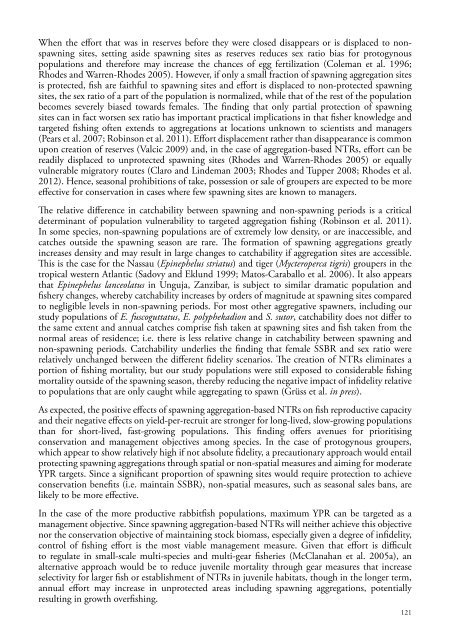WIOMSA-CORDIO spawning book Full Doc 10 oct 13.pdf
WIOMSA-CORDIO spawning book Full Doc 10 oct 13.pdf
WIOMSA-CORDIO spawning book Full Doc 10 oct 13.pdf
Create successful ePaper yourself
Turn your PDF publications into a flip-book with our unique Google optimized e-Paper software.
When the effort that was in reserves before they were closed disappears or is displaced to non<strong>spawning</strong>sites, setting aside <strong>spawning</strong> sites as reserves reduces sex ratio bias for protogynouspopulations and therefore may increase the chances of egg fertilization (Coleman et al. 1996;Rhodes and Warren-Rhodes 2005). However, if only a small fraction of <strong>spawning</strong> aggregation sitesis protected, fish are faithful to <strong>spawning</strong> sites and effort is displaced to non-protected <strong>spawning</strong>sites, the sex ratio of a part of the population is normalized, while that of the rest of the populationbecomes severely biased towards females. The finding that only partial protection of <strong>spawning</strong>sites can in fact worsen sex ratio has important practical implications in that fisher knowledge andtargeted fishing often extends to aggregations at locations unknown to scientists and managers(Pears et al. 2007; Robinson et al. 2011). Effort displacement rather than disappearance is commonupon creation of reserves (Valcic 2009) and, in the case of aggregation-based NTRs, effort can bereadily displaced to unprotected <strong>spawning</strong> sites (Rhodes and Warren-Rhodes 2005) or equallyvulnerable migratory routes (Claro and Lindeman 2003; Rhodes and Tupper 2008; Rhodes et al.2012). Hence, seasonal prohibitions of take, possession or sale of groupers are expected to be moreeffective for conservation in cases where few <strong>spawning</strong> sites are known to managers.The relative difference in catchability between <strong>spawning</strong> and non-<strong>spawning</strong> periods is a criticaldeterminant of population vulnerability to targeted aggregation fishing (Robinson et al. 2011).In some species, non-<strong>spawning</strong> populations are of extremely low density, or are inaccessible, andcatches outside the <strong>spawning</strong> season are rare. The formation of <strong>spawning</strong> aggregations greatlyincreases density and may result in large changes to catchability if aggregation sites are accessible.This is the case for the Nassau (Epinephelus striatus) and tiger (Mycteroperca tigris) groupers in thetropical western Atlantic (Sadovy and Eklund 1999; Matos-Caraballo et al. 2006). It also appearsthat Epinephelus lanceolatus in Unguja, Zanzibar, is subject to similar dramatic population andfishery changes, whereby catchability increases by orders of magnitude at <strong>spawning</strong> sites comparedto negligible levels in non-<strong>spawning</strong> periods. For most other aggregative spawners, including ourstudy populations of E. fuscoguttatus, E. polyphekadion and S. sutor, catchability does not differ tothe same extent and annual catches comprise fish taken at <strong>spawning</strong> sites and fish taken from thenormal areas of residence; i.e. there is less relative change in catchability between <strong>spawning</strong> andnon-<strong>spawning</strong> periods. Catchability underlies the finding that female SSBR and sex ratio wererelatively unchanged between the different fidelity scenarios. The creation of NTRs eliminates aportion of fishing mortality, but our study populations were still exposed to considerable fishingmortality outside of the <strong>spawning</strong> season, thereby reducing the negative impact of infidelity relativeto populations that are only caught while aggregating to spawn (Grüss et al. in press).As expected, the positive effects of <strong>spawning</strong> aggregation-based NTRs on fish reproductive capacityand their negative effects on yield-per-recruit are stronger for long-lived, slow-growing populationsthan for short-lived, fast-growing populations. This finding offers avenues for prioritisingconservation and management objectives among species. In the case of protogynous groupers,which appear to show relatively high if not absolute fidelity, a precautionary approach would entailprotecting <strong>spawning</strong> aggregations through spatial or non-spatial measures and aiming for moderateYPR targets. Since a significant proportion of <strong>spawning</strong> sites would require protection to achieveconservation benefits (i.e. maintain SSBR), non-spatial measures, such as seasonal sales bans, arelikely to be more effective.In the case of the more productive rabbitfish populations, maximum YPR can be targeted as amanagement objective. Since <strong>spawning</strong> aggregation-based NTRs will neither achieve this objectivenor the conservation objective of maintaining stock biomass, especially given a degree of infidelity,control of fishing effort is the most viable management measure. Given that effort is difficultto regulate in small-scale multi-species and multi-gear fisheries (McClanahan et al. 2005a), analternative approach would be to reduce juvenile mortality through gear measures that increaseselectivity for larger fish or establishment of NTRs in juvenile habitats, though in the longer term,annual effort may increase in unprotected areas including <strong>spawning</strong> aggregations, potentiallyresulting in growth overfishing.121


















